Dirty air in big cities, poor diet, constant stress - all this negatively affects the condition of the skin. All these factors affect the functioning of the sebaceous glands, causing them to work faster and longer. Acne is no longer just a problem for teenagers. How to deal with these unpleasant formations, which in cosmetology are called “imperfections”?
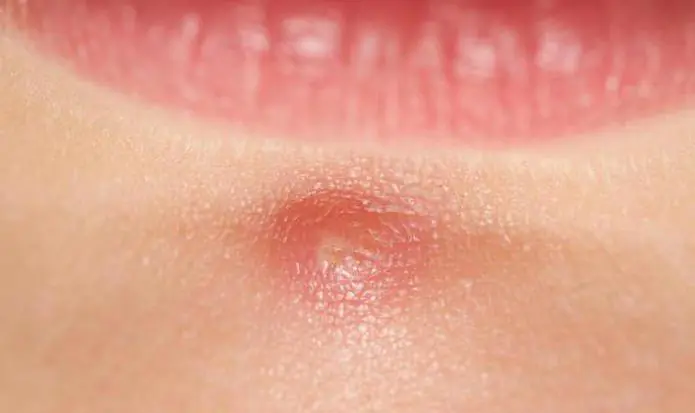
General recommendations
For those who suffer from any type of acne, experts give important recommendations. They must be followed regardless of the specific type of acne that worries the patient. Firstly, you should not squeeze pimples. This can lead to the formation of boils. The infection will spread throughout the body. In exceptional cases, it may even penetrate the brain. Also, squeezing leads to a scar subsequently remaining on the skin at the site of the imperfection.
After squeezing out pimples, wounds remain on the skin, in the treatment of which the cream with a bactericidal and wound-healing effect “ARGOSULFAN ®” has proven itself well. Unlike many antibacterial ointments that have long been familiar to us, to which microbes have developed resistance, it contains silver sulfathiazole, to which bacteria do not become accustomed. The active substance of the cream “ARGOSULFAN ®” has a wide spectrum of antibacterial action and promotes rapid healing of the wound without the formation of a rough scar.
There are contraindications. You need to read the instructions or consult a specialist.
Also, under no circumstances should you steam pimples - this will lead to further spread of the bacterial infection. One more important recommendation should be remembered: those who suffer from acne should not use cleansing scrubs or wipe the skin with ice cubes, as this increases inflammation and has a damaging effect on the skin.
Sometimes patients believe that they can cope with the problem on their own by searching on the Internet for descriptions of different types of acne, photos and names. But self-medication can cause irreparable harm to the skin. If we are not talking about the simplest type of acne - blackheads - you need to be treated only by a qualified dermatologist.
Different types of acne and their treatment
The reasons why acne occurs can be very different - from genetic predisposition to bacterial infections. Experts distinguish two categories of acne – non-inflammatory and inflammatory. The first group includes white and blackheads. Moreover, most often you can hear complaints from patients about blackheads. It is quite possible to cure this type of acne on your own - but only in the initial stages. The second type - inflammatory acne - includes a large number of different formations. These include conglobate acne, colds and red pimples.
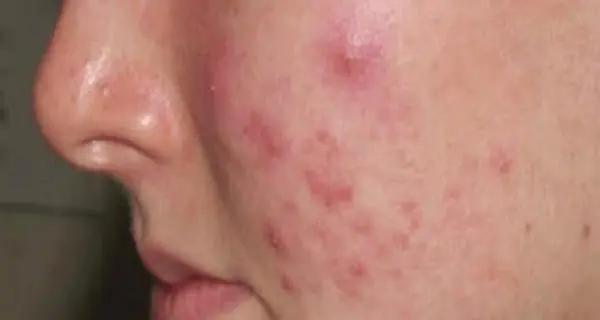
Acne conglobata
One of the most common types of acne is the so-called acne conglobata. Typically they occur on the face, back and chest. Conglobate acne looks like large nodes located in the deep layers of the skin and sometimes involving the upper layers of subcutaneous fat. Their diameter in some cases can reach 2 cm. Such acne can also merge with each other, forming conglomerates. After opening them, ulcers form that do not heal for a long time, and then large scars. In some cases, the nodes merge with each other, forming the so-called cutaneous sinus tracts, which seem to “undermine” the skin of the torso and face.
This type of acne on the face causes a lot of inconvenience. It is impossible to take a photo, as they look extremely unattractive and are difficult to disguise. Acne conglobata often causes a decrease in self-confidence. Various psychological complexes appear. This type of acne has other names: multiple, or piled up. This is one of the most severe forms of acne; it often recurs and becomes chronic. When suppuration occurs, boils and abscesses often form.

Reasons for appearance
It is believed that the cause of this type of acne is largely due to genetically determined high levels of testosterone. Also, hormonal balance can be disrupted throughout life due to exposure to environmental factors. Another reason is the proliferation of various bacteria on the surface of the skin. Their vital activity leads to damage to the walls of the sebaceous glands located in the lower layers of the skin, which leads to the development of inflammatory reactions. Experts also identify a number of provoking factors that lead to the occurrence of this type of acne:
- Frequent stress, as well as anxiety and depressive disorders. When a person is in such states for a long time, this provokes increased production of the so-called “substance P”, which provokes disturbances in the functioning of the sebaceous glands.
- Dietary disorders. It is believed that this type of acne can be caused by excessive consumption of foods with a high content of iodine and bromine (iodized salt, as well as seafood).
- Taking steroid hormones, anticonvulsants, antidepressants.
- Negative environmental influences: solar radiation, skin pollution from city dust, too frequent washing of the skin with soap, poorly selected cosmetics, mechanically injured skin.
- Smoking. Refers to the main factors that provoke the appearance of conglobate acne.
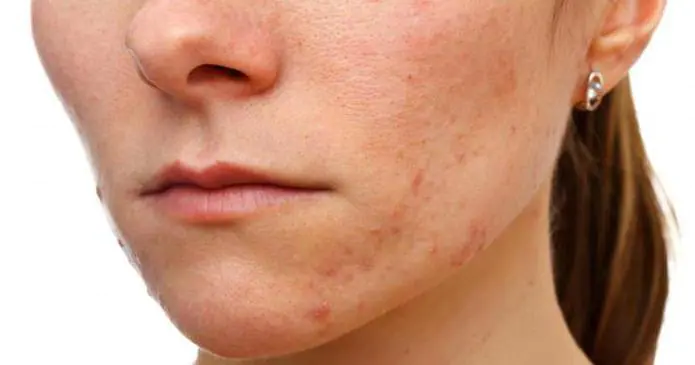
Treatment of conglobate acne
In many ways, treatment tactics depend on the age and gender of the patient, the type of activity, and lifestyle. The doctor must assess what stage the disease is at and whether there are any disturbances in the functioning of the internal organs. Therapy is selected taking into account individual characteristics and type of acne. A photo may not be enough to make a diagnosis, so you should not contact a doctor about this problem via the Internet. For successful therapy, an in-person visit to a specialist is necessary. First, the doctor prescribes previous therapy, which consists of the following processes:
- Sebometry – procedures for determining the amount of sebum on the surface of the skin;
- Study of hormonal levels, as well as the level of skin moisture;
- Study of skin microrelief using video monitoring;
- Consultation with a gynecologist and endocrinologist.
Systemic therapy
Consists of the following procedures:
- Prescribing antibiotics according to specific regimens. Doctors often prescribe Cefotaxime or Kefzol intravenously or intramuscularly. The duration of the course of antibiotics is up to 14 days, and Prednisolone is often additionally prescribed.
- Taking combined oral contraceptives. Medicines are prescribed even in cases where testosterone levels are not elevated. Before taking COCs, a preliminary consultation with a gynecologist is required.
- A course of retinoids. The drugs are prescribed after antibiotic therapy has been administered.
In addition, local remedies are also prescribed:
- Ointments and emulsions containing antibiotics - zinc ointment, ointment with gentamicin, Clindamycin gel.
- Retinoids in cream form (Retin A, Differin).
- Non-drug therapy - laser treatment, oxygen-ozone therapy.
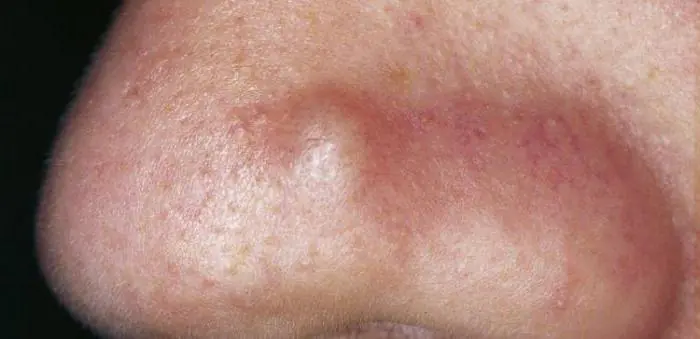
Non-inflammatory acne
Acne that is not accompanied by an inflammatory process is called comedones. They appear when the skin pores or mouths of hair follicles become contaminated with a mixture of sebum and dead skin cells. In turn, comedones are divided into two types - open and closed. Open comedones are a type of pimples on the face that are commonly called blackheads. They appear as dark dots. At first, the sebum that clogs the pore is colorless, but then gradually darkens. The size of a comedone is usually no more than 2 mm. This type of acne can be treated on your own, but it is recommended to see a doctor to avoid infection.
Among all types of acne in children and adolescents, this type is the most common. As a rule, it does not require additional therapy, and treatment includes means that can help reduce the formation of comedones. As a rule, preparations containing salicylic acid and azelaic acid are used. Tretionin is considered a particularly highly active agent, aimed at reducing the number of comedones. If the patient is well tolerated, Tretionin is applied to the affected areas of the skin once a day. Azelaic acid is used 2 times a day. These drugs are used for several months until complete recovery is achieved.
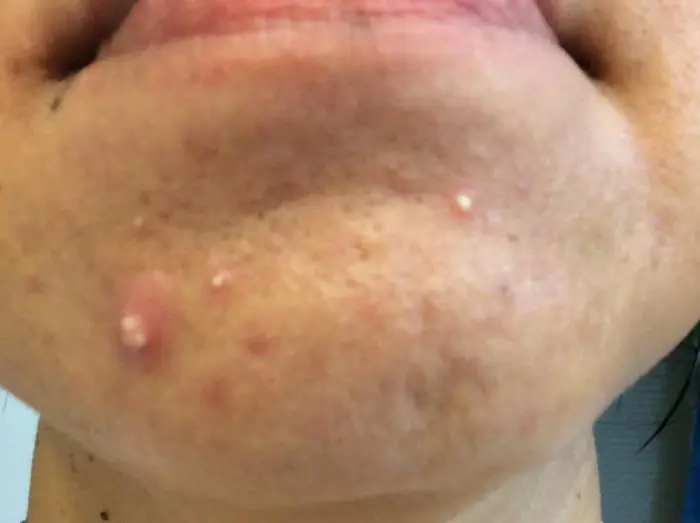
Inflammatory acne
One of the most common types of acne on the face and back is red acne. They are inflamed nodules on the surface of the skin, the size of which can reach 5 mm. This type belongs to the group of inflammatory acne. Their red color indicates the occurrence of an inflammatory process. Most often, red pimples are a reaction of the body's immune system to bacterial activity. If an infection occurs, the pimple may become larger and more painful. After some time, pus comes to the surface, and the acne gradually disappears.
Treatment of red pimples
Experts warn: red pimples should not be squeezed. After all, these actions can bring acne to the boil stage. The best therapy is to wipe the skin with a special lotion with antiseptic properties or aloe juice. In case of acne breakout, the wound should be treated with an alcohol-containing product.
If this type of acne appears on the back or other parts of the body, you should consult a doctor. Typically, laser or chemical peeling, ultrasonic cleaning, and ozone therapy are prescribed as therapy of this type. After consultation with a specialist, treatment can be continued at home. Zinc or ichthyol ointments, drugs "Zinerit", "Differin", "Curiosin" and others are usually prescribed.
Traditional medicine methods are also effective. You can make your own compresses or lotions from a decoction of calendula, chamomile, and nettle. The use of white clay is also effective. A special mask made from clay and calendula infusion cleanses the skin well.
Purulent pimples, the reasons for their appearance
This is another type of inflammatory acne. Among all types of acne on the skin, this type is the most unpredictable. A purulent pimple, as a rule, matures for a long time before suddenly showing itself “in all its glory.” This type of acne appears due to increased activity of the sebaceous glands. As a result, bacteria begin to multiply intensively on the surface of the skin and the inflammatory process begins. Often purulent acne appears on other parts of the body - they are also the most common among other types of acne on the back. Also, small purulent acne appears as a result of the body’s reaction to taking certain medications - steroids or antibiotics. Also, this type of acne can occur on various parts of the body due to hormonal imbalance. The likelihood of purulent acne is reduced with proper hygiene.
Types of acne on hands
Rashes on the hands are divided into several types. Firstly, acne on the hands can be of an infectious type and occur for the same reasons as on other parts of the body. Secondly, rashes on the hands can appear due to an allergic reaction of the body. It should be noted that often various types of acne on the hands indicate the presence of an infection or fungus - the cause may be eczema, scabies and other diseases. If acne occurs due to an allergic reaction, it is worth remembering that it can be life-threatening. That is why, if you notice acne on your hands, you should consult a doctor as soon as possible. Don’t rack your brains looking at the different types of acne on your hands in photos on the Internet. Timely consultation with a doctor is the key to quick recovery and health safety.
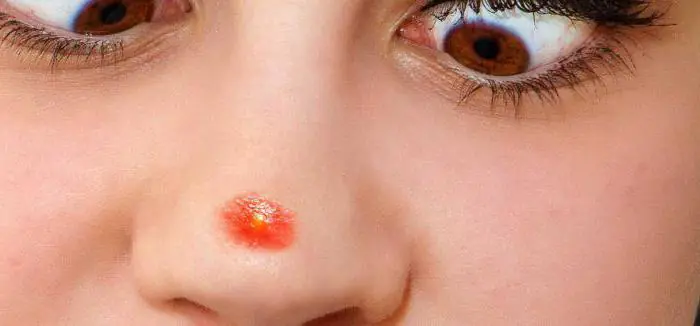
Cold pimples
During the cold season, cold acne becomes especially common. This is due to weakened immunity, which cannot fully fight various viruses and bacteria. Cold weather, drafts, and frequent hypothermia lead not only to acute respiratory infections, but also to the occurrence of this type of acne. A photo of this type of acne, like others, cannot be called aesthetic. Acne looks like lumps, which over time develop into extensive skin inflammation, sometimes with a white head at the top. However, unlike other categories of acne, cold pimples do not contain pus and therefore cannot be squeezed out. Pus accumulates inside such pimples gradually. They also take a long time to ripen, in some cases within 1-2 weeks. These pimples are also very difficult to disguise as they appear as red lesions. They appear most often on the face - on the lips, forehead, chin, head.
Treatment of cold acne
Typically, antiseptics, Vishnevsky ointment, and ichthyol ointment are used to combat cold acne. Using an antiseptic solution, you can significantly limit the spread of inflammation on the skin. For this purpose, preparations that contain salicylic acid, alcohol, and iodine are used. Antiseptics must be applied pointwise. This helps destroy bacteria on the surface of the skin.
Often, acne of this type appears on problematic skin, which is characterized by an increased level of sebum production. It clogs pores, mixes with dust and dead skin particles, thus creating a favorable environment for the proliferation of pathogenic microorganisms. Their waste products create an inflammatory process on the surface of the skin. In this case, ointments with an antiseptic effect can provide good help, which will destroy harmful microorganisms, reduce inflammation, and also have an analgesic effect. These include Levomekol, syntomycin ointment, and Baziron AS.
An affordable and effective drug - Vishnevsky ointment
Vishnevsky ointment is one of the most affordable and reliable drugs for the treatment of colds. It contains natural ingredients - birch tar, ichthyol, and castor oil. The ointment helps speed up the process of pimple maturation and its release. For maximum effect, you need to apply a thick layer of ointment on a piece of sterile tissue or gauze, apply it to the pimple and secure it overnight with an adhesive plaster. The main advantage of Vishnevsky ointment is its safety. The drug can also be used to treat other types of acne on the body. A significant drawback is the specific smell that not everyone will like.
Ichthyol ointment
Ichthyol ointment is also an excellent way to treat colds. It is made on the basis of ichthyol and petroleum jelly. Ichthyol ointment differs from Vishnevsky ointment in that it cannot accelerate the ripening of cold acne. However, it is able to draw pus out. Therefore, ichthyol ointment is best applied to an already mature pimple.
"Levomekol"
Excellent fight against inflammatory processes. At the initial stage of acne formation, you need to apply a thin layer several times a day to the painful area of the skin. After the pimple is opened, you can apply bandages containing ointment, this will significantly speed up the healing process and will also prevent possible complications.
Syntomycin ointment
Since cold pimples are characterized by increased pain, syntomycin ointment is well suited for their treatment. It quickly relieves discomfort. The ointment contains chloramphenicol, which belongs to the class of antibiotics. Using the product helps reduce inflammation and accelerate tissue regeneration.
"Baziron AS" is a medicinal gel widely used in the treatment of acne. It can be used to eliminate acne of various origins - colds, acne conglobata on the face and back. The gel is also used to treat various types of acne on the legs. The gel should be applied 2 times a day - morning and evening. "Baziron AS" is quickly absorbed without leaving any unpleasant sensations.
All methods described in this article are for informational purposes only. Before using any product, consultation with a specialist is necessary. You cannot treat inflammatory acne on your own, as this can only worsen the situation.
Acne is considered an unpleasant cosmetic defect that can appear on any part of the body, including the face.
There are different types of skin acne, which are classified according to their severity, level of inflammation and the reasons for their appearance on the face.
To choose an effective treatment method, it is important to determine what types of acne appear on the patient’s face and whether they are a sign of any dangerous pathology.
Symptoms
A subcutaneous purulent pimple looks like a hard growth, colored reddish or white and slightly rising above the epidermis.
When such a compaction matures, a bright red tubercle is formed, and when pressure is applied to it, pain appears. The size of a red pimple can reach more than 2 cm.
Often, when large purulent accumulations form on the face, the growth of other types of acne increases. In complicated situations, large nodes give the skin an unhealthy reddish tint, and it becomes very lumpy.
The location of such areas is mainly the areas most susceptible to the inflammatory process, that is, the arms, shoulders, face and neck.
For a long time, red subcutaneous pimples do not form purulent pustules, and are accompanied by pain when pressed and severe itching.
Causes
One of the most common causes of acne on the face is considered to be changes in the body's hormonal levels.
Most often, such disruptions occur during adolescence, when the greatest activity of hormones is observed.
In addition, increased production of hormones in the body occurs during pregnancy, breastfeeding and menopause.
Hormonal imbalance often affects the functioning of the sebaceous glands and causes the development of hyperkeratosis.
In addition, the following reasons can trigger the appearance of acne on the face:
- pathologies of the digestive tract;
- improper and irrational nutrition;
- failure to maintain skin hygiene;
- exposure to adverse environmental factors on the body;
- stressful situations and emotional stress;
- infectious diseases;
- use of low-quality cosmetics;
- exposure to chemicals.
All processes of human life are closely interconnected and the failure of any of the systems can result in the appearance of acne on the face.
Types of acne on the face
All acne on the face is divided into inflamed and non-inflamed.
In an adult
In adults, various types of rashes may appear on the face and some of them may indicate dangerous pathologies progressing in the human body.
Inflamed pimples are clearly visible on the face due to their bright red hue around the rash. Pimples have purulent contents and when you press on them, slight pain appears.
Inflamed rashes are divided into the following types:
- Papules - these are red spots on the face in which there is no purulent content. Such rashes rise slightly above the skin in the form of small tubercles. When you press on a pimple, it turns slightly pale, but over time it returns to its color.
- Pustule It is a pimple with pus inside. Externally, such a rash has a white head in the center of the elevation and can form from a papule. Experts do not recommend squeezing out pustules, since there is a high risk of spreading infection and blood poisoning.
- Nodes - This is a type of subcutaneous formations that are localized in the deep layers of the epidermis. These pimples are dark red, burgundy or bluish in color. The size of the nodes can reach several centimeters in diameter and are accompanied by pain even at rest.
- Cysts - these are several nodes located nearby, which can be connected under the skin by cavities-fistulas. In such a situation, eliminating the cyst is quite problematic, and traces always remain in its place.
Uninflamed acne does not pose a danger to humans, since there is no inflammatory process in them.
At the same time, they can be the starting point for the appearance of papules and pustules, and therefore also require attention.
Such rashes on the body are called comedones and appear when the sebaceous gland is blocked by various impurities mixed with sebum.
Open comedones or blackheads appear as a result of oxidation and can reach several millimeters in size.
You can eliminate such rashes at home using special cosmetics.
Closed comedones appear when the lower part of the skin pores on the inside becomes clogged.
Small white bumps form on the face, and their contents cannot come out on their own.
Tar soap for acne on the face. More details here.
Video: Types of rashes on the face
In children
Experts identify several types of acne that can appear on a child’s face.
Miliaria is one of the most common causes of rash in childhood. Your baby's skin changes color and may turn bright pink.
Rashes with cloudy contents appear, and the red color of the epidermis is considered a sign of an inflammatory process.
Infectious prickly heat develops when, when a vesicle ruptures, microbes enter the wound and an inflammatory process develops.
An allergic reaction is accompanied by the appearance of rashes on the face and the cause of its development can be any product.
The most common location for red rashes is the chin and cheeks. There may be only redness of the facial skin without the appearance of acne and the child is bothered by severe itching.
Neonatal acne appears as a severe, small, red rash and does not require any treatment.
Pimples are not accompanied by itching and disappear on their own after a few months. When the sebaceous glands are blocked, small white nodules may appear on the child’s face.
Erythema toxicum is red pimples on a child's face that have gray heads. The rash primarily affects the face and scalp.
Possible complications
After acne, age spots may remain on the face, but they do not cause any discomfort or harm to the person.
Most often they disappear without special treatment after a few weeks. However, sometimes after rashes, scars may remain on the face, which are not only difficult to get rid of, but even completely impossible.
A scar can form on the skin in order to compensate for a skin defect caused by an inflammatory process. Scarring of the tissue ends at the moment when special fibroblast cells are released into the lesion.
What not to do
Acne is not only a cosmetic defect, but an inflammatory process of the skin, which is often complicated by other pathologies.
When squeezing out acne, there is a high risk of infection getting into the weakened area. Of particular danger is the nasolabial triangle, which consists of a large number of vessels supplying the brain. There is a high probability of developing pathologies such as meningitis and encephalitis.
With each squeeze, the number of formations such as boils increases. Even in the absence of infection, mechanical damage to the skin occurs and scars form.
Treatment
For successful treatment of acne on the face, it is recommended to consult a dermatologist.
Medication
You can improve the condition of the skin with rashes on the face using the following medications:
- Klenzit.
- Zenerite.
- Differin.
- Curiosin.
- Heparin ointment.
- Ichthyol ointment.
If the local use of ointments does not bring the desired effect, then oral antibiotics may be prescribed.
For this purpose the following may be prescribed:
- antibiotics;
- hormonal drugs;
- retinoids.
The use of certain medications is permitted after a preliminary examination of the patient and study of the individual characteristics of his body.
At home
It is necessary to begin treating acne at home with primary cleansing of the skin. For this purpose, it is allowed to use special cosmetics and this procedure should be carried out no more than twice a day.
Do not forget about moisturizing your facial skin, even if it is oily. It is best to choose creams that are water-based rather than fat- and oil-based.
At home, you can make soda baths and apply them to the pimple. You just need to dilute the soda with cold water and it is advisable to carry out this procedure daily.
ethnoscience
Some folk remedies have a good effect in eliminating rashes on the face:
- You can wipe your face with aloe juice after keeping the leaves of the plant in the refrigerator. It is necessary to grind the aloe, squeeze the juice from the mixture and wipe your face with it several times a day.
- You need to pour a tablespoon of dried calendula flowers with a glass of boiling water and leave the mixture for half an hour. The solution should be filtered, brought to room temperature and used for daily wiping of the facial skin.
- You can speed up the breakout of a pimple using an onion application. It is recommended to apply the baked onion to the inflamed pimple, secure it with a band-aid and leave it overnight.
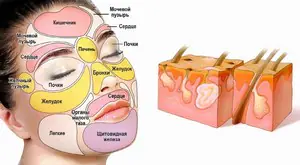
Acne and other types of pimples appear against the background of seborrhea, that is, excessive secretion of sebum. They form in areas of the skin that are richest in sebaceous glands. On average, there are about 900 glands on one square centimeter of the skin of the face, upper back and chest, while in other areas of the body their number does not exceed 100.
Features of acne formation
The reasons that cause the formation of acne on the body include not only excessive secretion of the sebaceous glands, but also infection of the skin with bacteria, hormonal imbalance and pathology of the hair follicle, for example, ingrown hairs. Most often, acne appears in teenagers, but adults often face this skin problem. Acne is one of the most common skin diseases.

The peak of the disease occurs between the ages of 13 and 18 years, while in girls acne begins to appear much earlier, but disappears faster. In guys, acne can take severe forms, worsening the quality of life and causing significant psychological problems, primarily due to a cosmetic defect. In men, this pathology can become chronic, and by the age of 40 it will develop into late-onset acne.
The very first signs are considered to be increased sebum secretion, as well as microcomedones. At this time, it is already necessary to contact a specialist in order to prevent the development of a severe form of the disease in the future.
Main types of acne
Many people call most skin growths acne, not knowing that there are many types of acne. Each species has its own scientific name. Depending on the external manifestations, the types of acne differ:
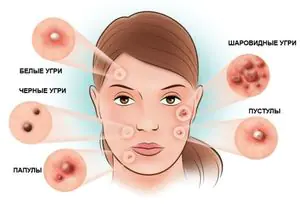
Papular.- Comedones.
- Indurative.
- Pustular.
- Phlegmonous.
- Abscessing, or suppurating indurative.
- Conglobate.
- Drain.
The choice of treatment for skin inflammation will depend on its severity. In mild cases, using home remedies will suffice. If there is a large number of any type of acne on the face, their treatment should begin with a visit to a dermatologist. Especially if the number of rashes is large, and the pimples are deep and merge with each other.
Almost all types of acne on the body form in stages. First, there is a blockage of the excretory ducts of the sebaceous glands due to increased secretion of sebum, which is caused by hypersensitivity of cells to sex hormones. Because of this, a breeding ground is created for various harmful microorganisms. When they multiply, they break down fat to produce fatty acids that damage the surface of the skin. As a result of such chemical irritation, an inflammatory process is formed.
Water pimples often appear on the face, which indicate the presence of the herpes virus in the body. These watery growths should not be confused with acne and blackheads. Some types of acne are even blue in color.
Comedones as the most common form
Comedones are mainly localized on the face and head. They form in the hair follicle, which becomes filled with dead skin cells and excess sebum. As a result, comedones form into small raised areas, papules, with black or white dots in the center. Some foods can trigger the formation of comedones, for example, those rich in animal fat, fried, spicy or salty foods. Such products are called comedogenic. Comedones are externally divided into two main types:
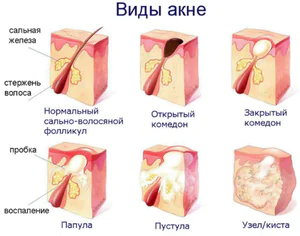
Black dots. These black plugs on the surface of the papules are filled with excess oil by skin cells. New growths acquire a black tint due not to the accumulation of dirt, as many believe, but due to improper reflection of light rays from clogged hair follicles. The color of sebum can also change when exposed to air. In some cases, the appearance of such a pathology is associated with improper use of cosmetics based on moisturizing components and oils. The reason for the formation of blackheads may be increased environmental humidity and pollution. In addition, blackheads can appear due to excessive use of soap or other cleansers. Dry skin can lead to increased sebum production and can also cause clogged pores. Most often, open comedones form on the chin, forehead and nose. Typically, special acne medications that can be purchased over the counter are sufficient to treat blackheads.- White heads. When the excretory duct of the sebaceous gland is completely blocked near the follicle itself, pimples with a white purulent head are formed. Such pimples are called closed comedones. Their contents do not reach the surface of the skin, but accumulate under the top layer of the skin and cause the formation of blisters. In this case, sebum does not come into contact with air, so acne does not darken. To get rid of this type of acne, you can use simple cosmetics. Non-inflammatory comedones are not accompanied by swelling and redness of the skin. You can get rid of white pimples at home using salicylic acid. This substance exfoliates dead skin cells well, opening the passage for excess sebum. That is why the composition of special lotions includes salicylic acid. Acne with a white head is less susceptible to treatment, so in addition to salicylic acid, retinoids, for example, Differin, are used to eliminate them.
Papular and pustular type
During inflammation, comedones form in papular appearance eels. This occurs due to the proliferation of pathogenic bacteria in the sebaceous glands, causing inflammation and the appearance of pus. Small, soft, pink or reddish bumps form on the surface of the skin. The skin around them is often slightly hyperemic. Quite often, these pimples are sensitive to touch and are accompanied by slight itching. Extruding contents will only intensify the inflammatory process, and in the future this can lead to scarring.
If a large number of such papules have formed on the skin, then this is a sign of severe or moderate acne that needs treatment. Inflammatory acne will be less responsive to treatment than comedones. To eliminate them, products based on benzoyl peroxide are used. The specialist should also prescribe antibiotics - local and for oral administration, isotretinoin preparations.
Pustular acne are pustules that often develop from comedones with white heads. A red, inflamed rim appears around the lesion. The neoplasm itself is filled with yellow or white pus. It may be irregular in shape. Pustular acne often merges with each other, protruding above the skin surface. As a rule, the formation of pustular elements does not associated with severe bacterial infection.
It is necessary to avoid squeezing out blackheads, as this can lead to the formation of dark spots or scars on the skin.
Indurative or nodular tubercles
This type of subcutaneous acne consists of large, painful nodules or bumps. They are formed when the sebaceous gland duct is completely blocked, as well as due to inflammation and irritation of the surrounding skin tissue. These neoplasms are dense to the touch, acne penetrates deep into the structure of the skin, and is often accompanied by pain. When such acne forms, the help of a dermatologist is necessary. As a rule, drug treatment with isotretinoin, which is taken orally for six months, is sufficient.
Abscessing cystic formations
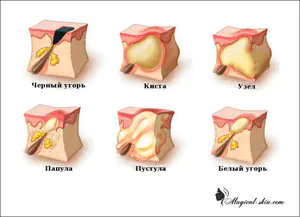
When suppuration of indurated acne is observed due to the proliferation of pathogenic bacteria, a cystic formation is formed, which is abscessed acne. They are filled with purulent contents and resemble boils in appearance. The formations are very painful, soft to the touch, and after opening, atrophic deep scars remain.
The course of the disease is relapsing. In this case specialist help needed, often requires consultation not only with a dermatologist, but also with an immunologist and an endocrinologist. Isotretinoin is also used for treatment. The abscess can be removed surgically.
Phlegmonous and conglobate forms of acne
Phlegmonous acne are formed when inflammation penetrates into the deep layer of the skin, and small cavities appear filled with pus. On the surface of the skin, acne manifests itself in the form of widespread lumpiness. Over time, the cavities begin to merge into large lesions, forming nodes of a purple hue. Over time, the phlegmonous formations break through, and purulent contents mixed with blood begin to come out through several holes. The course of the disease is long, it is very difficult to treat.
Conglobate form of acne is one of the heaviest. These acne often form on the neck, back, buttocks and chest. Externally, they appear as a large number of inflamed follicles, which can merge with neighboring areas of inflammation. Most often, such acne appears in men. The appearance of neoplasms associated with anabolic steroid use or testosterone.
Control methods and treatment principles
For mild skin diseases, it is enough to use special cosmetic lotions for at least 2 months. The average severity of the lesion requires taking appropriate medications prescribed by a dermatologist. Treatment in this case lasts several weeks, often in the first time after the start of therapy, the severity of the acne increases slightly. In severe stages of the disease the main goal is to reduce inflammation and scarring. The doctor prescribes a variety of medications and physical procedures that can improve the appearance of the skin and the condition of the sebaceous glands.
Local therapy is used to treat various types of acne. This may include medicine that is applied directly to the affected areas. Acne ointments and creams contain substances such as resorcinol, benzoyl peroxide, salicylic acid, zinc and sulfur derivatives. Prescription medications, such as retinoid ointments and antibacterial creams, are also used.
Tablet medications are used for systemic therapy. The doctor prescribes antibiotics: Erythromycin, Doxycycline, Tetracycline. These medications can destroy bacteria that cause acne suppuration and inflammation. If necessary, the specialist prescribes other drugs for treatment:
- Spironolactone.
- Oral contraceptives to normalize hormonal levels in women.
- Isotretinoin, which is a derivative of vitamin A.
- Antiandrogenic substances.
Due to the large number of side effects of Isotretinoin, this drug should only be prescribed by a doctor.
There is no overnight cure for acne. The disease must first be cured from the inside. That is why, if nodular pimples have already begun to form in the form of tubercles in large numbers, inside of which there is purulent content, you need to seek help from a dermatologist.



